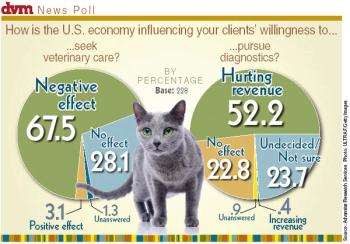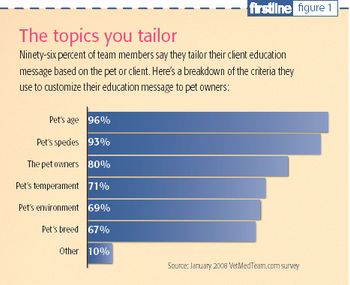
Fight that trend and attract cat owners to your practice.

The Pareto Principle is an observation (not a law) that most things in life are not distributed evenly. It could mean any or all of the following:

'Tis the season for creepy crawlies to worm their way into clients' and pets' lives. Remind clients of these disease prevention tips.

How should we handle aggressive clients who use foul language, throw invoices, or behave badly?

How do we tell clients we can't help them when they can't pay for the care their pet receives?

Review these techniques to help you prepare for your next encounter with aggressive clients.

Editor's Note: Understanding consumer behavior can help you as a clinician and business manager. DVM Newsmagazine asked five veterinary market leaders to join this year's DVM Newsmakers' Summit at CVC East in Baltimore. Following is the second of three excerpts from the panel discussion; the final one will be published next month.

Maintaining friendly eye contact often promotes trust, and can add emphasis to what we say.

These case studies show how to strengthen your relationships with clients and grow your practice.

How is the U.S. economy influencing your clients' willingness to seek veterinary care?

When stress drags down team members at Ontario Veterinary Hospital in Ontario, they pull themselves up with pull-ups.

Help cat owners provide a pain-free existence for their feline friends.

When clients ask if it's necessary, I explain that while we hope that test results will be normal, these tests can help us identify potentially serious conditions.

Q. Our practice is getting busier. How can we keep a personal touch?

A free client and public education seminar held at least once a year is a tremendous practice builder.

Clients with these attributes help you practice good medicine.

A referral is one of the highest compliments an organization can receive and, as such, deserves recognition.

Ninety-six percent of team members say they tailor their client education message based on the pet or client. Here's a breakdown of the criteria they use to customize their education message to pet owners.

And her veterinarian explains how he does it.

One size doesn't fit all in critical discussions with clients about their pets' health. Learn how to weave the threads of your conversation to match the needs of the pet in front of you.

Use this checklist to make sure you discuss necessary care recommendations with clients during visits.

When some clients brush off our post-surgery care instructions, they end up paying for it-twice.

How we communicate with clients can be a source of mutual understanding and positive action, leading to highly effective patient care, or a source of misunderstanding and frustration.

A few tweaks to your paperwork and front desk, and refill annoyances will be a thing of the past.

Some remarks from clients and colleagues can deflate your enthusiasm. Here's how to respond the next time their words make you ready to pop.

Dr. Melisa Hicks and her team at Blue Cross Veterinary Hospital in Long Beach, Calif., improve compliance by encouraging clients to prepay for fecal tests.

The six principles of adult learning provide a framework for building a protocol for ongoing client education.

Here in the Midwest, it's been a stormy season. Some states have seen record numbers of twisters, and we've had to kennel our dog during thunderstorms so many times this year we've stopped counting. If you've ever lived in an area where tornadoes are common, you know the chill the tornado siren sends when it starts to moan.

"The waiting area smelled of urine and pet odors." "The surroundings were dirty and depressing." Don't let these comments be from your clients.